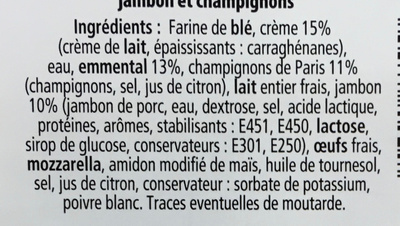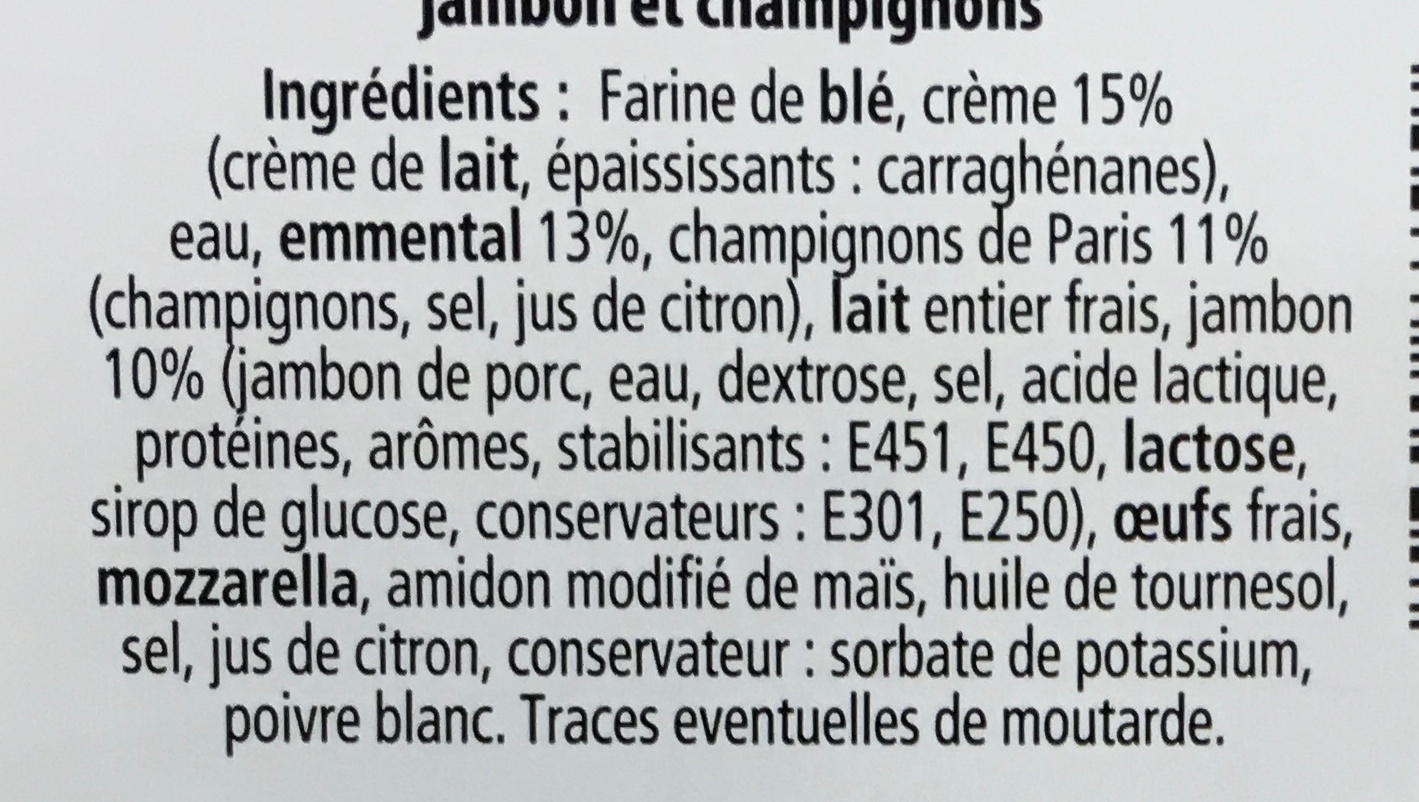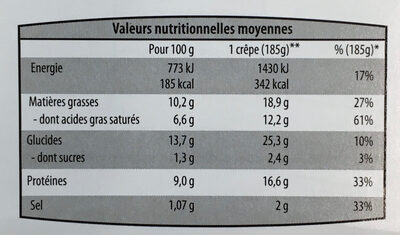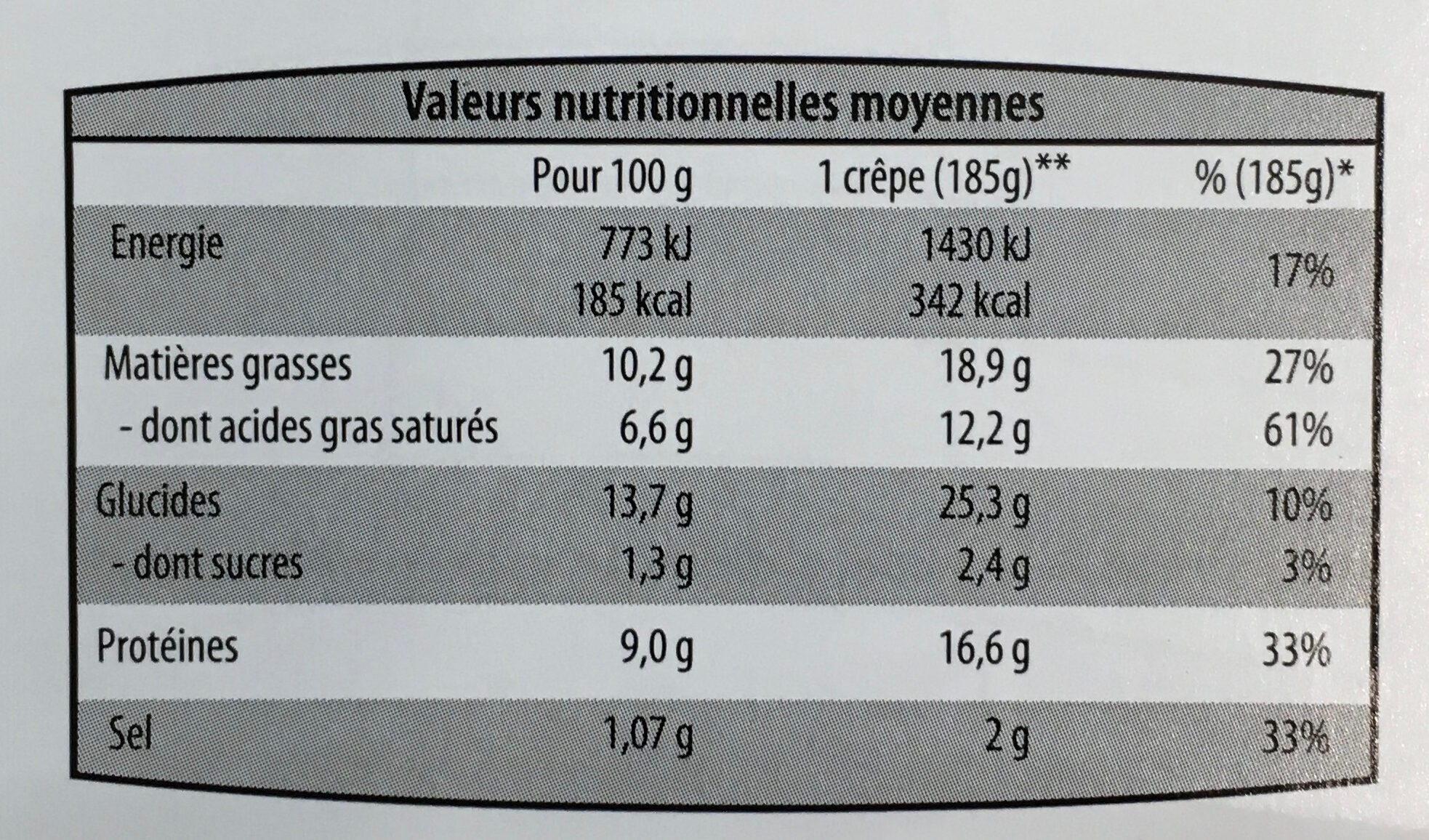Help us make food transparency the norm!
As a non-profit organization, we depend on your donations to continue informing consumers around the world about what they eat.
The food revolution starts with you!
Ficelles picarde - Pays Gourmand - 370 g
Ficelles picarde - Pays Gourmand - 370 g
Ambiguous barcode: This product has a Restricted Circulation Number barcode for products within a company. This means that different producers and stores can use the same barcode for different products.
×
This product page is not complete. You can help to complete it by editing it and adding more data from the photos we have, or by taking more photos using the app for Android or iPhone/iPad. Thank you!
×
Barcode: 26018799
Quantity: 370 g
Brands: Pays Gourmand
Categories: Meals, Crêpes and galettes, Fresh foods, Fresh meals, Ham and mushroom pancake in cheese sauce
Labels, certifications, awards:
French meat, French pork, Green Dot, Nutriscore, Nutriscore Grade C
Manufacturing or processing places: France
Traceability code: EMB 56231B1
Stores: Aldi
Countries where sold: France
Matching with your preferences
Health
Ingredients
-
37 ingredients
French: Farine de blé, crème 15% (crème de lait, épaississants : carraghénanes, eau, emmental 13%, champignons de Paris 11% (champignons, sel, jus de citron), lait entier frais, jambon 10% (jambon de porc, eau, dextrose, sel, acide lactique, protéines, arômes, stabilisants : E451, E450, lactose, sirop de glucose, conservateurs : E301, E250), œufs frais, mozzarella, amidon modifié de maïs, huile de tournesol, sel, jus de citron, conservateur : sorbate de potassium, poivre blanc.Allergens: Eggs, Gluten, MilkTraces: Mustard
Food processing
-
Ultra processed foods
Elements that indicate the product is in the 4 - Ultra processed food and drink products group:
- Additive: E14XX - Modified Starch
- Additive: E407 - Carrageenan
- Additive: E450 - Diphosphates
- Additive: E451 - Triphosphates
- Ingredient: Dextrose
- Ingredient: Flavouring
- Ingredient: Glucose
- Ingredient: Glucose syrup
- Ingredient: Lactose
- Ingredient: Thickener
Food products are classified into 4 groups according to their degree of processing:
- Unprocessed or minimally processed foods
- Processed culinary ingredients
- Processed foods
- Ultra processed foods
The determination of the group is based on the category of the product and on the ingredients it contains.
Additives
-
E202 - Potassium sorbate
Potassium sorbate (E202) is a synthetic food preservative commonly used to extend the shelf life of various food products.
It works by inhibiting the growth of molds, yeast, and some bacteria, preventing spoilage. When added to foods, it helps maintain their freshness and quality.
Some studies have shown that when combined with nitrites, potassium sorbate have genotoxic activity in vitro. However, potassium sorbate is generally recognized as safe (GRAS) by regulatory authorities.
-
E250 - Sodium nitrite
Sodium nitrite: Sodium nitrite is the inorganic compound with the chemical formula NaNO2. It is a white to slightly yellowish crystalline powder that is very soluble in water and is hygroscopic. It is a useful precursor to a variety of organic compounds, such as pharmaceuticals, dyes, and pesticides, but it is probably best known as a food additive to prevent botulism. It is on the World Health Organization's List of Essential Medicines, the most important medications needed in a basic health system.Nitrate or nitrite -ingested- under conditions that result in endogenous nitrosation has been classified as "probably carcinogenic to humans" by International Agency for Research on Cancer -IARC-.Source: Wikipedia
-
E270 - Lactic acid
Lactic acid: Lactic acid is an organic compound with the formula CH3CH-OH-COOH. In its solid state, it is white and water-soluble. In its liquid state, it is colorless. It is produced both naturally and synthetically. With a hydroxyl group adjacent to the carboxyl group, lactic acid is classified as an alpha-hydroxy acid -AHA-. In the form of its conjugate base called lactate, it plays a role in several biochemical processes. In solution, it can ionize a proton from the carboxyl group, producing the lactate ion CH3CH-OH-CO−2. Compared to acetic acid, its pKa is 1 unit less, meaning lactic acid deprotonates ten times more easily than acetic acid does. This higher acidity is the consequence of the intramolecular hydrogen bonding between the α-hydroxyl and the carboxylate group. Lactic acid is chiral, consisting of two optical isomers. One is known as L--+--lactic acid or -S--lactic acid and the other, its mirror image, is D--−--lactic acid or -R--lactic acid. A mixture of the two in equal amounts is called DL-lactic acid, or racemic lactic acid. Lactic acid is hygroscopic. DL-lactic acid is miscible with water and with ethanol above its melting point which is around 17 or 18 °C. D-lactic acid and L-lactic acid have a higher melting point. In animals, L-lactate is constantly produced from pyruvate via the enzyme lactate dehydrogenase -LDH- in a process of fermentation during normal metabolism and exercise. It does not increase in concentration until the rate of lactate production exceeds the rate of lactate removal, which is governed by a number of factors, including monocarboxylate transporters, concentration and isoform of LDH, and oxidative capacity of tissues. The concentration of blood lactate is usually 1–2 mM at rest, but can rise to over 20 mM during intense exertion and as high as 25 mM afterward. In addition to other biological roles, L-lactic acid is the primary endogenous agonist of hydroxycarboxylic acid receptor 1 -HCA1-, which is a Gi/o-coupled G protein-coupled receptor -GPCR-.In industry, lactic acid fermentation is performed by lactic acid bacteria, which convert simple carbohydrates such as glucose, sucrose, or galactose to lactic acid. These bacteria can also grow in the mouth; the acid they produce is responsible for the tooth decay known as caries. In medicine, lactate is one of the main components of lactated Ringer's solution and Hartmann's solution. These intravenous fluids consist of sodium and potassium cations along with lactate and chloride anions in solution with distilled water, generally in concentrations isotonic with human blood. It is most commonly used for fluid resuscitation after blood loss due to trauma, surgery, or burns.Source: Wikipedia
-
E301 - Sodium ascorbate
Sodium ascorbate: Sodium ascorbate is one of a number of mineral salts of ascorbic acid -vitamin C-. The molecular formula of this chemical compound is C6H7NaO6. As the sodium salt of ascorbic acid, it is known as a mineral ascorbate. It has not been demonstrated to be more bioavailable than any other form of vitamin C supplement.Sodium ascorbate normally provides 131 mg of sodium per 1‚000 mg of ascorbic acid -1‚000 mg of sodium ascorbate contains 889 mg of ascorbic acid and 111 mg of sodium-. As a food additive, it has the E number E301 and is used as an antioxidant and an acidity regulator. It is approved for use as a food additive in the EU, USA, and Australia and New Zealand.In in vitro studies, sodium ascorbate has been found to produce cytotoxic effects in various malignant cell lines, which include melanoma cells that are particularly susceptible.Source: Wikipedia
-
E407 - Carrageenan
Carrageenan (E407), derived from red seaweed, is widely employed in the food industry as a gelling, thickening, and stabilizing agent, notably in dairy and meat products.
It can exist in various forms, each imparting distinct textural properties to food.
However, its degraded form, often referred to as poligeenan, has raised health concerns due to its potential inflammatory effects and its classification as a possible human carcinogen (Group 2B) by the International Agency for Research on Cancer (IARC).
Nevertheless, food-grade carrageenan has been deemed safe by various regulatory bodies when consumed in amounts typically found in food.
-
E450 - Diphosphates
Diphosphates (E450) are food additives often utilized to modify the texture of products, acting as leavening agents in baking and preventing the coagulation of canned food.
These salts can stabilize whipped cream and are also found in powdered products to maintain their flow properties. They are commonly present in baked goods, processed meats, and soft drinks.
Derived from phosphoric acid, they're part of our daily phosphate intake, which often surpasses recommended levels due to the prevalence of phosphates in processed foods and drinks.
Excessive phosphate consumption is linked to health issues, such as impaired kidney function and weakened bone health. Though diphosphates are generally regarded as safe when consumed within established acceptable daily intakes, it's imperative to monitor overall phosphate consumption to maintain optimal health.
-
E451 - Triphosphates
Sodium triphosphate: Sodium triphosphate -STP-, also sodium tripolyphosphate -STPP-, or tripolyphosphate -TPP-,- is an inorganic compound with formula Na5P3O10. It is the sodium salt of the polyphosphate penta-anion, which is the conjugate base of triphosphoric acid. It is produced on a large scale as a component of many domestic and industrial products, especially detergents. Environmental problems associated with eutrophication are attributed to its widespread use.Source: Wikipedia
Ingredients analysis
-
Palm oil free
No ingredients containing palm oil detected
-
Non-vegan
Non-vegan ingredients: Cream, Cream, Emmental, Fresh whole milk, Ham, Ham, Lactose, Fresh egg, Mozzarella
-
Non-vegetarian
Non-vegetarian ingredients: Ham, Ham
-
Details of the analysis of the ingredients
fr: Farine de _blé_, crème 15%, crème de _lait_, épaississants (carraghénanes), eau, _emmental_ 13%, champignons de Paris 11% (champignons, sel, jus de citron), _lait_ entier frais, jambon 10% (jambon de porc, eau, dextrose, sel, acide lactique, protéines, arômes, stabilisants (e451), e450, _lactose_, sirop de glucose, conservateurs (e301), e250), _œufs_ frais, _mozzarella_, amidon modifié de maïs, huile de tournesol, sel, jus de citron, conservateur (sorbate de potassium), poivre blanc- Farine de _blé_ -> en:wheat-flour - vegan: yes - vegetarian: yes - ciqual_proxy_food_code: 9410
- crème -> en:cream - vegan: no - vegetarian: yes - ciqual_food_code: 19402 - percent: 15
- crème de _lait_ -> en:cream - vegan: no - vegetarian: yes - ciqual_food_code: 19402
- épaississants -> en:thickener
- carraghénanes -> en:e407 - vegan: yes - vegetarian: yes
- eau -> en:water - vegan: yes - vegetarian: yes - ciqual_food_code: 18066
- _emmental_ -> en:emmental - vegan: no - vegetarian: maybe - ciqual_food_code: 12115 - percent: 13
- champignons de Paris -> en:cultivated-mushroom - vegan: yes - vegetarian: yes - ciqual_food_code: 20010 - percent: 11
- champignons -> en:mushroom - vegan: yes - vegetarian: yes - ciqual_food_code: 20010
- sel -> en:salt - vegan: yes - vegetarian: yes - ciqual_food_code: 11058
- jus de citron -> en:lemon-juice - vegan: yes - vegetarian: yes - ciqual_food_code: 2028
- _lait_ entier frais -> en:fresh-whole-milk - vegan: no - vegetarian: yes - ciqual_food_code: 19023
- jambon -> en:ham - vegan: no - vegetarian: no - ciqual_proxy_food_code: 28205 - percent: 10
- jambon de porc -> en:ham - vegan: no - vegetarian: no - ciqual_proxy_food_code: 28205
- eau -> en:water - vegan: yes - vegetarian: yes - ciqual_food_code: 18066
- dextrose -> en:dextrose - vegan: yes - vegetarian: yes - ciqual_proxy_food_code: 31016
- sel -> en:salt - vegan: yes - vegetarian: yes - ciqual_food_code: 11058
- acide lactique -> en:e270 - vegan: yes - vegetarian: yes
- protéines -> en:protein - vegan: maybe - vegetarian: maybe
- arômes -> en:flavouring - vegan: maybe - vegetarian: maybe
- stabilisants -> en:stabiliser
- e451 -> en:e451 - vegan: yes - vegetarian: yes
- e450 -> en:e450 - vegan: yes - vegetarian: yes
- _lactose_ -> en:lactose - vegan: no - vegetarian: yes
- sirop de glucose -> en:glucose-syrup - vegan: yes - vegetarian: yes - ciqual_proxy_food_code: 31016
- conservateurs -> en:preservative
- e301 -> en:e301 - vegan: yes - vegetarian: yes
- e250 -> en:e250 - vegan: yes - vegetarian: yes
- _œufs_ frais -> en:fresh-egg - vegan: no - vegetarian: yes - ciqual_food_code: 22000
- _mozzarella_ -> en:mozzarella - vegan: no - vegetarian: maybe - ciqual_food_code: 19590
- amidon modifié de maïs -> en:modified-corn-starch - vegan: yes - vegetarian: yes - ciqual_food_code: 9510
- huile de tournesol -> en:sunflower-oil - vegan: yes - vegetarian: yes - from_palm_oil: no - ciqual_food_code: 17440
- sel -> en:salt - vegan: yes - vegetarian: yes - ciqual_food_code: 11058
- jus de citron -> en:lemon-juice - vegan: yes - vegetarian: yes - ciqual_food_code: 2028
- conservateur -> en:preservative
- sorbate de potassium -> en:e202 - vegan: yes - vegetarian: yes
- poivre blanc -> en:white-pepper - vegan: yes - vegetarian: yes - ciqual_food_code: 11019
en:meat -> en:meat
en:pork -> en:pork
Nutrition
-
Poor nutritional quality
⚠ ️Warning: the amount of fruits, vegetables and nuts is not specified on the label, it was estimated from the list of ingredients: 11This product is not considered a beverage for the calculation of the Nutri-Score.
Positive points: 0
- Proteins: 5 / 5 (value: 9, rounded value: 9)
- Fiber: 0 / 5 (value: 0, rounded value: 0)
- Fruits, vegetables, nuts, and colza/walnut/olive oils: 0 / 5 (value: 11, rounded value: 11)
Negative points: 12
- Energy: 2 / 10 (value: 773, rounded value: 773)
- Sugars: 0 / 10 (value: 1.3, rounded value: 1.3)
- Saturated fat: 6 / 10 (value: 6.6, rounded value: 6.6)
- Sodium: 4 / 10 (value: 428, rounded value: 428)
The points for proteins are not counted because the negative points are greater or equal to 11.
Nutritional score: (12 - 0)
Nutri-Score:
-
Nutrient levels
-
Fat in moderate quantity (10.2%)
What you need to know- A high consumption of fat, especially saturated fats, can raise cholesterol, which increases the risk of heart diseases.
Recommendation: Limit the consumption of fat and saturated fat- Choose products with lower fat and saturated fat content.
-
Saturated fat in high quantity (6.6%)
What you need to know- A high consumption of fat, especially saturated fats, can raise cholesterol, which increases the risk of heart diseases.
Recommendation: Limit the consumption of fat and saturated fat- Choose products with lower fat and saturated fat content.
-
Sugars in low quantity (1.3%)
What you need to know- A high consumption of sugar can cause weight gain and tooth decay. It also augments the risk of type 2 diabetes and cardio-vascular diseases.
Recommendation: Limit the consumption of sugar and sugary drinks- Sugary drinks (such as sodas, fruit beverages, and fruit juices and nectars) should be limited as much as possible (no more than 1 glass a day).
- Choose products with lower sugar content and reduce the consumption of products with added sugars.
-
Salt in moderate quantity (1.07%)
What you need to know- A high consumption of salt (or sodium) can cause raised blood pressure, which can increase the risk of heart disease and stroke.
- Many people who have high blood pressure do not know it, as there are often no symptoms.
- Most people consume too much salt (on average 9 to 12 grams per day), around twice the recommended maximum level of intake.
Recommendation: Limit the consumption of salt and salted food- Reduce the quantity of salt used when cooking, and don't salt again at the table.
- Limit the consumption of salty snacks and choose products with lower salt content.
-
-
Nutrition facts
Nutrition facts As sold
for 100 g / 100 mlAs sold
per serving (185 g)Compared to: Ham and mushroom pancake in cheese sauce Energy 773 kj
(185 kcal)1,430 kj
(342 kcal)+9% Fat 10.2 g 18.9 g +34% Saturated fat 6.6 g 12.2 g +76% Carbohydrates 13.7 g 25.3 g -12% Sugars 1.3 g 2.41 g -54% Fiber - - Proteins 9 g 16.6 g +12% Salt 1.07 g 1.98 g +10% Fruits‚ vegetables‚ nuts and rapeseed‚ walnut and olive oils (estimate from ingredients list analysis) 11 % 11 % Carbon footprint from meat or fish 74 g 137 g
Environment
-
Eco-Score E - Very high environmental impact
⚠ ️Select a country in order to include the full impact of transportation.The Eco-Score is an experimental score that summarizes the environmental impacts of food products.→ The Eco-Score was initially developped for France and it is being extended to other European countries. The Eco-Score formula is subject to change as it is regularly improved to make it more precise and better suited to each country.Life cycle analysis
-
Average impact of products of the same category: D (Score: 28/100)
Category: Ham and mushroom pancake in cheese sauce
Category: Ham and mushroom pancake in cheese sauce
- PEF environmental score: 1.13 (the lower the score, the lower the impact)
- including impact on climate change: 7.70 kg CO2 eq/kg of product
Stage Impact Agriculture
75.1 %Processing
15.8 %Packaging
3.8 %Transportation
1.5 %Distribution
0.8 %Consumption
3.0 %
Bonuses and maluses
-
Origins of ingredients with a high impact
Malus: -5
Environmental policy: -5
Transportation: 0
Origin of the product and/or its ingredients % of ingredients Impact Unknown 100 %High France 0 %Medium
-
Packaging with a medium impact
Malus: -10
Shape Material Recycling Impact Tray Plastic High
Eco-Score for this product
-
Impact for this product: E (Score: 13/100)
Product: Ficelles picarde - Pays Gourmand - 370 g
Life cycle analysis score: 28
Sum of bonuses and maluses: -15
Final score: 13/100
-
Carbon footprint
-
Equal to driving 4.0 km in a petrol car
770 g CO² per 100g of product
The carbon emission figure comes from ADEME's Agribalyse database, for the category: Ham and mushroom pancake in cheese sauce (Source: ADEME Agribalyse Database)
Stage Impact Agriculture
79.9 %Processing
10.4 %Packaging
5.2 %Transportation
2.8 %Distribution
0.5 %Consumption
1.2 %
Packaging
-
Packaging with a medium impact
-
Packaging parts
Tray (Plastic)
-
Packaging materials
Material % Packaging weight Packaging weight per 100 g of product Plastic
-
Transportation
-
Origins of ingredients
Origins of ingredients with a high impact
Origin of the product and/or its ingredients % of ingredients Impact Unknown 100 %High France 0 %Medium
Report a problem
-
Incomplete or incorrect information?
Category, labels, ingredients, allergens, nutritional information, photos etc.
If the information does not match the information on the packaging, please complete or correct it. Open Food Facts is a collaborative database, and every contribution is useful for all.
Data sources
Product added on by tacite
Last edit of product page on by lou57.
Product page also edited by jusdekiwi, kiliweb, naruyoko, packbot, roboto-app, segundo, yuka.sY2b0xO6T85zoF3NwEKvlk59et3QogLUEEPgi3DR-NuoNaXMWNNJz9PCDqs, yuka.sY2b0xO6T85zoF3NwEKvlmZ5fP_c-BLhFBHmtUO538qOBba1XOso2I_BA6s, yuka.sY2b0xO6T85zoF3NwEKvlmhCbNTVhQjuCjrlp3K2nd6-cYHtet1p0orEaas.











